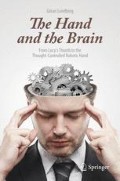Abstract
Creative hands can be traced back to cave art, decorations and various types of artistically designed objects created over the last 100,000 years, primarily in South Africa and Europe. As a symbol of creativity, the hand plays a key role in our culture, particularly in art and music. However, many of the most well-known artists and musicians suffered from various types of hand problems but were still able to perform their art, thanks to well-preserved brain function – their creative capacity. Musicians lacking one arm have been able to perform music at very high artistic levels. The brains of experienced musicians may be somewhat different from the brains of nonmusicians, with well-developed white matter and an enlarged corpus callosum connecting the two brain hemispheres, and in violin players the cortical representation of the left hand may be enlarged. Experienced musicians may view their instrument as an integral part of their bodies.
Access this chapter
Tax calculation will be finalised at checkout
Purchases are for personal use only
References
Berg L. Gryning över Kalahari: hur människan blev människa. Stockholm: Ordfront; 2005.
Henshilwood CS, d’Errico F, van Niekerk KL, Coquinot Y, Jacobs Z, Lauritzen SE, et al. A 100,000-year-old ochre-processing workshop at Blombos Cave, South Africa. Science. 2011;334(6053):219–22.
Balter M. Human evolution. Early start for human art? Ochre may revise timeline. Science. 2009;323(5914):569.
Texier PJ, Porraz G, Parkington J, Rigaud JP, Poggenpoel C, Miller C, et al. From the Cover: a Howiesons Poort tradition of engraving ostrich eggshell containers dated to 60,000 years ago at Diepkloof Rock Shelter, South Africa. Proc Natl Acad Sci U S A. 2010;107(14):6180–5.
Rigaud JP. Art treasures from the ice age. Lascaux Cave. Nat Geogr. 1988;174:482–99.
Balter M. Origins. On the origin of art and symbolism. Science. 2009;323(5915):709–11.
Clottes J, Courtin J. La grotte Cosquer: peintures et gravures de la grotte engloutie. Paris: Seuil, cop; 1994.
Coghlan A. Cave art rescue bid creates new threats. New Scientist. 2009. p. 12.
Sandblom P. Creativity and disease. How illness affects literature, art and music. New York: Marion Boyers; 1997.
Drozdov I, Kidd M, Modlin IM. Evolution of one-handed piano compositions. J Hand Surg Am. 2008;33(5):780–6.
Edel T. Piano music for one hand. Bloomington: Indiana University Press; 1994.
Patterson DL. One handed: a guide to piano music for one hand. Westport: Greenwood Press; 1999.
Ekström A. Interviewing Hans Pålsson about Beethoven Sydsvenska Dagbladet (Swedish newspaper). 20 Feb 2010. p. 2.
Schlaug G, Jancke L, Huang Y, Staiger JF, Steinmetz H. Increased corpus callosum size in musicians. Neuropsychologia. 1995;33(8):1047–55.
Gaser C, Schlaug G. Brain structures differ between musicians and non-musicians. J Neurosci. 2003;23(27):9240–5.
Hutchinson S, Lee LH, Gaab N, Schlaug G. Cerebellar volume of musicians. Cereb Cortex. 2003;13(9):943–9.
Bengtsson SL, Nagy Z, Skare S, Forsman L, Forssberg H, Ullen F. Extensive piano practicing has regionally specific effects on white matter development. Nat Neurosci. 2005;8(9):1148–50.
Pantev C, Engelien A, Candia V, Elbert T. Representational cortex in musicians. Plastic alterations in response to musical practice. Ann N Y Acad Sci. 2001;930:300–14.
Ragert P, Schmidt A, Altenmuller E, Dinse HR. Superior tactile performance and learning in professional pianists: evidence for meta-plasticity in musicians. Eur J Neurosci. 2004;19(2):473–8.
Elbert T, Pantev C, Wienbruch C, Rockstroh B, Taub E. Increased cortical representation of the fingers of the left hand in string players. Science. 1995;270(5234):305–7.
Hashimoto I, Suzuki A, Kimura T, Iguchi Y, Tanosaki M, Takino R, et al. Is there training-dependent reorganization of digit representations in area 3b of string players? Clin Neurophysiol. 2004;115(2):435–47.
Bara-Jimenez W, Catalan MJ, Hallett M, Gerloff C. Abnormal somatosensory homunculus in dystonia of the hand. Ann Neurol. 1998;44(5):828–31.
Rosenkranz K, Butler K, Williamon A, Cordivari C, Lees AJ, Rothwell JC. Sensorimotor reorganization by proprioceptive training in musician’s dystonia and writer’s cramp. Neurology. 2008;70(4):304–15.
McKenzie AL, Nagarajan SS, Roberts TP, Merzenich MM, Byl NN. Somatosensory representation of the digits and clinical performance in patients with focal hand dystonia. Am J Phys Med Rehabil. 2003;82(10):737–49.
Levy LM, Hallett M. Impaired brain GABA in focal dystonia. Ann Neurol. 2002;51(1):93–101.
Stinear CM, Byblow WD. Impaired modulation of intracortical inhibition in focal hand dystonia. Cereb Cortex. 2004;14(5):555–61.
Winspur I, Wynn Parry CB. The musicians hand. London: Martin Dunitz; 1998.
Tubiana R, Amadio PC. Medical problems of the instrumentalist musician. London: Martin Dunitz; 2000.
Zatorre RJ, Chen JL, Penhune VB. When the brain plays music: auditory-motor interactions in music perception and production. Nat Rev Neurosci. 2007;8(7):547–58.
Geistrand M. Interviewing J Musker. Sydsvenska Dagbladet (Swedish newspaper). 1 Feb 2009.
Author information
Authors and Affiliations
Rights and permissions
Copyright information
© 2014 Springer-Verlag London
About this chapter
Cite this chapter
Lundborg, G. (2014). Creative Hands. In: The Hand and the Brain. Springer, London. https://doi.org/10.1007/978-1-4471-5334-4_12
Download citation
DOI: https://doi.org/10.1007/978-1-4471-5334-4_12
Published:
Publisher Name: Springer, London
Print ISBN: 978-1-4471-5333-7
Online ISBN: 978-1-4471-5334-4
eBook Packages: MedicineMedicine (R0)

